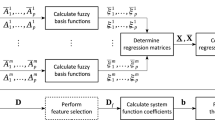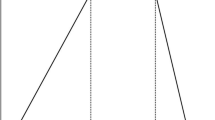Abstract
This paper proposes a new multivariable fuzzy inference system without explicitly defined fuzzy rules. This system uses Gaussian fuzzy sets for the inputs and linearly and nonlinearly parameterized system functions. To determine their parameters, linear and nonlinear regressions are used. The linear regression is realized by the ridge regression and the nonlinear regression by the Levenberg–Marquardt algorithm. The input fuzzy sets are determined by a multi-objective genetic algorithm with a feature selection method. In the case of linearly parameterized system functions, the following methods are considered: F-test, ReliefF, a regression tree, neighborhood component analysis, and lasso regression. In the case of nonlinearly parameterized system functions, terms from the so-called term matrix are coded in an individual, and they are selected by using a genetic algorithm. In the paper, two pairs of objective functions are defined: one pair, consisting of the number of active predictors and the root of the mean squared error, for constructing fuzzy estimators, and the second pair, consisting of the number of active predictors and confusion values, for constructing fuzzy classifiers. These multi-criteria objective functions enable the selection of models from the Pareto fronts taking into account the compromise between model accuracy and its simplification. The proposed method was tested on four examples: approximation of a one-variable function, two-class classification of banknotes, prediction of a time series, and prediction of automobile fuel consumption. The conducted experiments confirmed the usefulness of the proposed solution.























Similar content being viewed by others
Data Availability Statement
All experiments were carried out on publicly available data sets.
References
Aghaeipoor F, Javidi MM (2019) MOKBL+MOMs: an interpretable multi-objective evolutionary fuzzy system for learning high-dimensional regression data. Inform Sci 496:1–24. https://doi.org/10.1016/j.ins.2019.04.035
Aydogan EK, Karaoglan I, Pardalos PM (2012) HGA: hybrid genetic algorithm in fuzzy rule-based classification systems for high-dimensional problems. Appl Soft Comput J 12(2):800–806. https://doi.org/10.1016/j.asoc.2011.10.010
BIMK Group (2022) PlatEMO evolutionary multi-objective optimization platform user manual 3:4
Chen SM, Hsin WC (2015) Weighted fuzzy interpolative reasoning based on the slopes of fuzzy sets and particle swarm optimization techniques. IEEE Trans Cybern 45(7):1250–1261. https://doi.org/10.1109/TCYB.2014.2347956
Dhiman G, Singh KK, Slowik A, Chang V, Yildiz AR, Kaur A, Garg M (2021) EMoSOA: a new evolutionary multi-objective seagull optimization algorithm for global optimization. Int J Mach Learn Cybern 12(2):571–596. https://doi.org/10.1007/s13042-020-01189-1
Dua D, Graff C (2021) UCI machine learning repository. http://archive.ics.uci.edu/ml
Gu ZM, Wang GG (2020) Improving nsga-iii algorithms with information feedback models for large-scale many-objective optimization. Future Gener Comput Syst 107:49–69. https://doi.org/10.1016/j.future.2020.01.048
Güven MK, Passino KM (2001) Avoiding exponential parameter growth in fuzzy systems. IEEE Trans Fuzzy Syst 9(1):194–199. https://doi.org/10.1109/91.917125
Hoerl AE, Kennard RW (1970) Ridge regression: biased estimation for nonorthogonal problems. Technometrics 12(1):55–67
Holland JH (1992) Adaptation in natural and artificial systems: an introductory analysis with applications to biology, control, and artificial intelligence. MIT Press, USA
Isfahani MK, Zekri M, Marateb HR, Mañanas MA (2019) Fuzzy jump wavelet neural network based on rule induction for dynamic nonlinear system identification with real data applications. PLoS ONE 14(12):1–26. https://doi.org/10.1371/journal.pone.0224075
Jang JR (1993) ANFIS: adaptive-network-based fuzzy inference system. IEEE Trans Syst, Man, Cybern 23(3):665–685. https://doi.org/10.1109/21.256541
Li C, Wu T (2011) Adaptive fuzzy approach to function approximation with PSO and RLSE. Expert Syst Appl 38(10):13266–13273
Lin L, Guo F, Xie X, Luo B (2015) Novel adaptive hybrid rule network based on TS fuzzy rules using an improved quantum-behaved particle swarm optimization. Neurocomputing 149:1003–1013. https://doi.org/10.1016/j.neucom.2014.07.033
Liu Z, Chen CL, Zhang Y, Xiong LH (2012) Type-2 hierarchical fuzzy system for high-dimensional data-based modeling with uncertainties. Soft Comput 16(11):1945–1957. https://doi.org/10.1007/s00500-012-0867-8
Lughofer E, Nikzad-Langerodi R (2020) Robust generalized fuzzy systems training from high-dimensional time-series data using local structure preserving PLS. IEEE Trans Fuzzy Syst 28(11):2930–2943. https://doi.org/10.1109/TFUZZ.2019.2945535
Maghawry A, Hodhod R, Omar Y, Kholief M (2021) An approach for optimizing multi-objective problems using hybrid genetic algorithms. Soft Comput 25(1):389–405. https://doi.org/10.1007/s00500-020-05149-3
Márquez AA, Márquez FA, Roldán AM, Peregrín A (2013) An efficient adaptive fuzzy inference system for complex and high dimensional regression problems in linguistic fuzzy modelling. Knowledge-Based Syst 54:42–52. https://doi.org/10.1016/j.knosys.2013.05.012
Mellal MA, Salhi A (2021) Multi-objective system design optimization via PPA and a fuzzy method. Int J Fuzzy Syst 23(5):1213–1221. https://doi.org/10.1007/s40815-021-01068-z
Novakovic BM (1999) Fuzzy logic control synthesis without any rule base. IEEE Trans Syst, Man, Cybern, Part B: Cybern 29(3):459–466. https://doi.org/10.1109/3477.764883
Seber G, Wild C (2005) Nonlinear regression. Wiley Series in Probability and Statistics Wiley, Hoboken
Singh S, Singh S, Banga VK (2020) Design of fuzzy logic system framework using evolutionary techniques. Soft Comput 24(6):4455–4468. https://doi.org/10.1007/s00500-019-04207-9
Sun J, Miao Z, Gong D, Zeng XJ, Li J, Wang G (2020) Interval multiobjective optimization with memetic algorithms. IEEE Trans Cybern 50(8):3444–3457. https://doi.org/10.1109/TCYB.2019.2908485
Sun TY, Tsai SJ, Tsai CH, Huo CL, Liu CC (2008) Nonlinear function approximation based on least Wilcoxon Takagi-Sugeno fuzzy model. In: 2008 Eighth International Conference on Intelligent Systems Design and Applications, 1, pp. 312–317
Tak N, Evren AA, Tez M, Egrioglu E (2018) Recurrent type-1 fuzzy functions approach for time series forecasting. Appl Intell 48(1):68–77. https://doi.org/10.1007/s10489-017-0962-8
Takagi T, Sugeno M (1985) Fuzzy identification of systems and its applications to modeling and control. IEEE Trans Syst Man Cybern 1:116–132. https://doi.org/10.1109/TSMC.1985.6313399
The MathWorks Inc (2020) Fuzzy Logic Toolbox User’s Guide. Natick, Massachusetts, United States
The MathWorks Inc (2020) Global Optimization Toolbox User’s Guide. Natick, Massachusetts, United States
The MathWorks Inc (2020) Statistics and machine learning Toolbox User’s Guide. Natick, Massachusetts, United States
The MathWorks Inc (2021) Fuzzy Logic Toolbox User’s Guide. Natick, Massachusetts, United States
Tian Y, Cheng R, Zhang X, Jin Y (2017) PlatEMO: a MATLAB platform for evolutionary multi-objective optimization. IEEE Comput Intell Mag 12(4):73–87
Unal AN, Kayakutlu G (2020) Multi-objective particle swarm optimization with random immigrants. Complex Intell Syst 6(3):635–650. https://doi.org/10.1007/s40747-020-00159-y
Wang LX, Mendel J (1992) Generating fuzzy rules by learning from examples. IEEE Trans Syst Man Cybern 22(6):1414–1427. https://doi.org/10.1109/21.199466
Wang S, Chung KFL, Lu J, Han B, Hu D (2004) Fuzzy inference systems with no any rule base and linearly parameter growth. J Control Theory Appl 2(2):185–192. https://doi.org/10.1007/s11768-004-0067-x
Whitley DCSU (1994) A genetic algorithm tutorial by Darrell Whitley. Statist Comput 2(4):65–85. https://doi.org/10.1007/BF00175354
Wiktorowicz K, Krzeszowski T (2020) Approximation of two-variable functions using high-order Takagi-Sugeno fuzzy systems, sparse regressions, and metaheuristic optimization. Soft Comput 24:1–15. https://doi.org/10.1007/s00500-020-05238-3
Wiktorowicz K, Krzeszowski T (2020) Training High-Order Takagi-Sugeno fuzzy systems using batch least squares and particle swarm optimization. Int J Fuzzy Syst 22(1):22–34. https://doi.org/10.1007/s40815-019-00747-2
Yang YK, Sun TY, Huo CL, Yu YH, Liu CC, Tsai CH (2013) A novel self-constructing radial basis function neural-fuzzy system. Appl Soft Comput 13(5):2390–2404
Yi JH, Xing LN, Wang GG, Dong J, Vasilakos AV, Alavi AH, Wang L (2020) Behavior of crossover operators in nsga-iii for large-scale optimization problems. Inform Sci 509:470–487. https://doi.org/10.1016/j.ins.2018.10.005
Zhang Y, Wang GG, Li K, Yeh WC, Jian M, Dong J (2020) Enhancing moea/d with information feedback models for large-scale many-objective optimization. Inform Sci 522:1–16. https://doi.org/10.1016/j.ins.2020.02.066
Zhao L, Qian F, Yang Y, Zeng Y, Su H (2010) Automatically extracting T-S fuzzy models using cooperative random learning particle swarm optimization. Appl Soft Comput 10(3):938–944. https://doi.org/10.1016/j.asoc.2009.10.012
Funding
No funding was received for conducting this study.
Author information
Authors and Affiliations
Corresponding author
Ethics declarations
Conflicts of interest
Not applicable.
Code availability
The MATLAB code is available at: https://www.mathworks.com/matlabcentral/fileexchange/95848-rfis-regression-based-fuzzy-inference-system.
Ethical approval
Not applicable.
Consent to participate
Not applicable.
Consent for publication
Not applicable.
Additional information
Publisher's Note
Springer Nature remains neutral with regard to jurisdictional claims in published maps and institutional affiliations.
Rights and permissions
About this article
Cite this article
Wiktorowicz, K. RFIS: regression-based fuzzy inference system. Neural Comput & Applic 34, 12175–12196 (2022). https://doi.org/10.1007/s00521-022-07105-8
Received:
Accepted:
Published:
Issue Date:
DOI: https://doi.org/10.1007/s00521-022-07105-8




